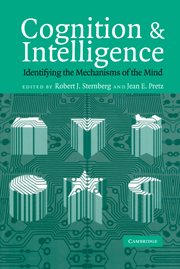Book contents
- Frontmatter
- Contents
- Preface
- 1 Information Processing and Intelligence: Where We Are and Where We Are Going
- 2 Mental Chronometry and the Unification of Differential Psychology
- 3 Reductionism versus Charting: Ways of Examining the Role of Lower-Order Cognitive Processes in Intelligence
- 4 Basic Information Processing and the Psychophysiology of Intelligence
- 5 The Neural Bases of Intelligence: A Perspective Based on Functional Neuroimaging
- 6 The Role of Working Memory in Higher-Level Cognition: Domain-Specific versus Domain-General Perspectives
- 7 Higher-Order Cognition and Intelligence
- 8 Ability Determinants of Individual Differences in Skilled Performance
- 9 Complex Problem Solving and Intelligence: Empirical Relation and Causal Direction
- 10 Intelligence as Smart Heuristics
- 11 The Role of Transferable Knowledge in Intelligence
- 12 Reasoning Abilities
- 13 Measuring Human Intelligence with Artificial Intelligence: Adaptive Item Generation
- 14 Marrying Intelligence and Cognition: A Developmental View
- 15 From Description to Explanation in Cognitive Aging
- 16 Unifying the Field: Cognition and Intelligence
- Author Index
- Subject Index
- References
1 - Information Processing and Intelligence: Where We Are and Where We Are Going
Published online by Cambridge University Press: 23 November 2009
- Frontmatter
- Contents
- Preface
- 1 Information Processing and Intelligence: Where We Are and Where We Are Going
- 2 Mental Chronometry and the Unification of Differential Psychology
- 3 Reductionism versus Charting: Ways of Examining the Role of Lower-Order Cognitive Processes in Intelligence
- 4 Basic Information Processing and the Psychophysiology of Intelligence
- 5 The Neural Bases of Intelligence: A Perspective Based on Functional Neuroimaging
- 6 The Role of Working Memory in Higher-Level Cognition: Domain-Specific versus Domain-General Perspectives
- 7 Higher-Order Cognition and Intelligence
- 8 Ability Determinants of Individual Differences in Skilled Performance
- 9 Complex Problem Solving and Intelligence: Empirical Relation and Causal Direction
- 10 Intelligence as Smart Heuristics
- 11 The Role of Transferable Knowledge in Intelligence
- 12 Reasoning Abilities
- 13 Measuring Human Intelligence with Artificial Intelligence: Adaptive Item Generation
- 14 Marrying Intelligence and Cognition: A Developmental View
- 15 From Description to Explanation in Cognitive Aging
- 16 Unifying the Field: Cognition and Intelligence
- Author Index
- Subject Index
- References
Summary
INTRODUCTION
Intelligence tests are about one hundred years old. If you agree with Boring (1923) that intelligence is what the intelligence tests measure, then the science of intelligence is one hundred years old. I will call this psychometrically defined intelligence. Empirically the study of psychometric intelligence is a booming field, for it has led to a very large literature, impressive technological developments, and coherent relationships among test scores (Carroll, 1993). However, it has a weakness.
A purely psychometric approach to intelligence lets the technology of measurement define the concept, rather than the concept defining an appropriate measurement technology. Along with many others, I prefer a more conceptual, less boring approach. The conceptual definition of intelligence as individual variation in mental competence has a longer history. In the sixteenth century the Spanish philosopher Juan Huarte de San Juan (Huarte, 1575/1991) proposed a multifaceted theory of intelligence that was not too far from today's crystallized–fluid distinction. In the nineteenth century, Galton (1883) used laboratory techniques for measuring individual differences in basic mental processes that are recognizable ancestors of paradigms used in today's laboratories. And for that matter, Binet, the founder of modern testing, was not entirely atheoretic (Sternberg, 1990). All interesting theories of intelligence try to go beyond test scores to connect individual differences with a theory of how the mind works. Developing such a theory is the province of cognitive psychology.
- Type
- Chapter
- Information
- Cognition and IntelligenceIdentifying the Mechanisms of the Mind, pp. 1 - 25Publisher: Cambridge University PressPrint publication year: 2004
References
- 1
- Cited by



